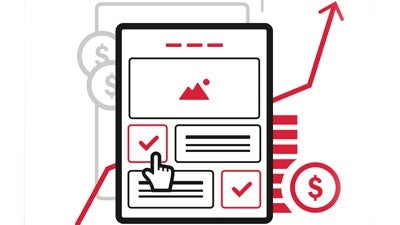Home > Technology > eCommerce >
Use Landing Pages to Turn Social Engagement into Business Gains
By: SmallBizClub

Social media marketing has gained a lot of steam in the digital marketing world in the past decade. As businesses big and small realized social media’s massive potential, marketers were sent on a never-ending quest to facilitate user engagement in an effort to turn audience interaction into meaningful business gains. A lot of marketers can say they’re doing well on social media, but have you ever asked yourself what those claims are based on?
In any marketing effort, the end goal should always be positive returns on investment (ROI). Applying that logic to social media marketing, the challenge becomes two-pronged: First, you have to prove that social media marketing does generate leads and sales. Second, you have to attribute goal conversions and measure them accurately to find out how much of your business success should be credited to social media traction.
Doing that is a tall order. Most social media platforms don’t offer analytics platforms that will help you track the commercial performance of your efforts. Facebook and Twitter will show you stats pertaining to reach and engagement, but these data leave a wide disconnect between how well you’re doing in social networking sites versus how much of that actually makes business sense. To bridge the gap, you’ll need to use social media landing pages that are optimized for social media marketing.
Landing Pages: Your Converter of Traffic into Leads and Customers
A landing page is a webpage designed specifically for receiving traffic from a pre-determined source. In this case, it’s social media marketing and perhaps paid advertising in the social networks. Landing pages often have singular objectives that marketers want to focus on. Whether the objective is to capture leads, close some sales or to facilitate downloads, the routine is similar every time: use slick writing to spark interest, state the benefits, build some trust and issue a powerful call to action.
Related Article: Top 5 Tips for a High Converting Landing Page
For social media marketing campaigns, landing pages are hosted within the business owner’s website. Here, marketers have complete control over design, content, user experience and tracking choices. That’s the stark difference between a landing page and simple social network pages—you’re not bound by the network’s guidelines and you can pursue any type of activity that you want to do. Just drive the traffic to the landing page and make sure you make a compelling case that will persuade users to take your call to action.
But how exactly do you do that? Optimizing landing page copy, design and usability are the top areas to think about if you want to maximize conversion rates. Here are some best practices:
Write Headlines that Make People Stay
The headline is arguably the most important part of every landing page. Even if you’re using video to deliver your message, a headline is necessary because it’s the first thing that catches the audience’s eyes. In a matter of 2-3 seconds, the audience will decide whether they want to continue with your landing page or not based on what they perceive from the headline. If they see the messaging as vague, irrelevant, or shady, they’re bound to go away.
Hire an experienced copywriter to put together the headline and the supporting copy for you. These professionals are not just creative; they also have extensive swipe files based on winning campaigns that they can use to concoct great headlines for your campaign. You will usually be given a few to choose from. Narrow it down to two or three and make a final choice based on the results of testing.
For that reason, A/B testing and multivariate testing should be taken advantage of. These processes allow you to see which headline performs best based on the response of a small sample of your full audience.
Tease the Reader with Sub-Headlines
A headline is a brief, but powerful statement that encapsulates the essence of an entire landing page in just a few words. A sub-headline is the follow-through to the headline, which gives readers a better idea of what to expect. Effective copywriters tend to use sub-headlines to tease the audience to pull people deeper into the conversion funnel. This is an optional component of your landing page copy, but it does make sense to have them in most cases.
Introduce the Problem in the Lead Paragraph
The first paragraph of your copy should be snappy and direct to the point. Start things off by talking about your audience’s pain points. Make them remember their problem and expound by stating objectively how their lives are worse off if they don’t do something about it.
This part of your landing page copy should be 1-3 sentences long. Anything beyond that is excessive and might be too much for the average reader. Use very direct sentences stated in the active voice. The idea is to create a sense of urgency on the part of the reader so he can acknowledge that the problem exists and something has to be done about it.
Introduce Your Solution
The next paragraph should start introducing a solution to the problem that you’re offering. This could be a product or a service and it could be paid (for sales purposes) or free (for lead generation.). Make sure to state the name clearly and describe it in an impactful yet easy-to-understand manner.
Outline the Benefits
The next thing your audience will want to know is how exactly the offering will solve their problems. You can let them know using benefit statements written in brief, clear and powerful bullet points. Four is usually the magic number but three or five is fine. Let the audience know what it stands to gain by heeding your call to action and how that increases their pleasures and reduces their pains.
Issue a Powerful Call-to-Action
After clinching the benefits section, ask the audience to take affirmative action by filling up a form or clicking a button. The call to action should be clear and easy to see. It should also stand out with its size, font and a color scheme that contrasts with the rest of the landing page.
List Down the Features
In long form copy, you can list down the features of your offer. If it’s an ebook, you can say how many pages there are, how many images you put in and how many lessons you deliver in it. If it’s a product like a laptop, listing down the key technical specifications is the way to go.
Add Some Social Proof
A great way to boost landing page performance is to build trust with social proof elements. Testimonials, badges from government and non-profit institutions, certifications and award-giving bodies are excellent additions. Guarantees of security and confidentiality will also help.
Sweeten the Deal
If you’re selling something with your landing page, offer fun extras like discounts, rebates or freebies. Adding to the perceived value of your offer makes the audience feel smarter about their choice to buy from you. Providing the consumer with a sense of empowerment is a proven way to get sales figures rolling.
Create Some Excitement
If you feel your audience will need one last nudge to make them convert, create a sense of urgency by limiting supply, making the availability period limited and offering early bird incentives. This allows you to create immediate momentum and reduces the risk of people postponing their action and forgetting about your offer.
Ultimately, social media marketing is an important part of every digital marketing strategy. However, your website is still central to your program because that’s where you do business. Landing pages are the key to converting engaged traffic to paying customers. Use them and optimize them to get the best returns from your investments.
Author: Vincent Sevilla is a professional graphic designer and musician, web designer for WebsiteSetup, and he also has a background in online marketing. You can follow him on Twitter @easyvince and on Google+
Published: June 9, 2015
3418 Views
3418 Views












